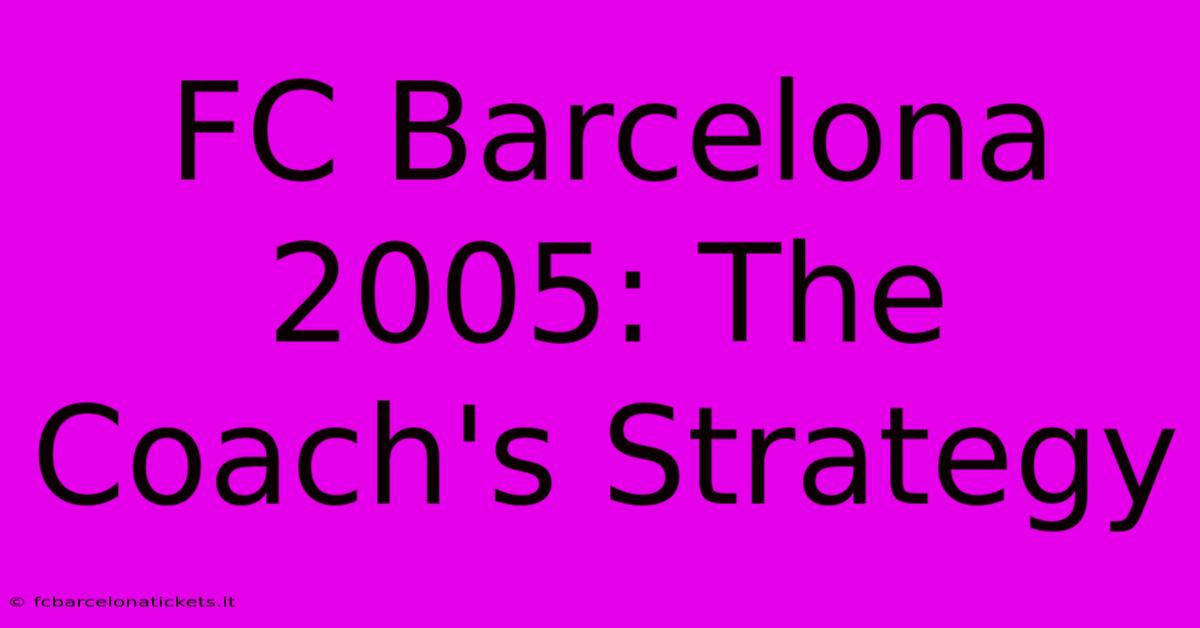FC Barcelona 2005: The Coach's Strategy

Table of Contents
FC Barcelona 2005: Unpacking Frank Rijkaard's Masterful Strategy
The 2005 FC Barcelona team wasn't just a collection of talented players; it was a finely tuned machine orchestrated by the tactical genius of Frank Rijkaard. This article delves into the strategic brilliance that defined Rijkaard's approach, leading to a period of unprecedented success for the Catalan giants. We'll examine his key tactical elements, the role of individual players within his system, and the overall impact on Barça's playing style.
Rijkaard's Tactical Masterclass: A Blend of Attack and Control
Rijkaard's philosophy centered around a possession-based, attacking style that built upon the legendary Cruyffian principles, yet incorporated his own unique innovations. Forget the rigid formations; his approach was fluid, adaptable, and often depended on the opponents' weaknesses. However, several core tenets remained consistent throughout his tenure:
1. Dominating Possession: The Foundation of Attack
Maintaining control of the ball was paramount. Rijkaard instilled a deep understanding of positional play, ensuring players consistently created passing triangles and maintained short, sharp passing sequences. This constant circulation of the ball not only frustrated opponents but also created numerous scoring opportunities. Maintaining possession wasn't just about keeping the ball; it was about dictating the tempo and wearing down the opposition.
2. Fluid Formation and Interchangeable Roles: Adaptability on the Pitch
While often employing a 4-3-3 formation, Rijkaard encouraged a fluidity that saw players swap positions seamlessly. This meant wingers cutting inside, midfielders dropping deeper, and forwards making darting runs. This constant movement made Barça incredibly difficult to mark and created unpredictable attacking threats. The system relied on players' intelligence and understanding of the game, making them adaptable to different situations on the field.
3. Exploiting Space and Utilizing Width: Creating Overloads
Rijkaard expertly utilized the width of the pitch. His wingers were instructed to stretch the defense, creating space for the midfielders to operate and for the central striker to exploit gaps. This combination of width and central penetration was a hallmark of his tactical approach, overwhelming opponents with multiple attacking options. He constantly sought to create overloads, either in midfield or in the attacking third, to break down defensive lines.
Key Players and Their Roles within the System
Rijkaard's success was also predicated on the exceptional talent at his disposal. However, it was his ability to integrate these players into a cohesive unit that truly set him apart:
- Ronaldinho: The Brazilian maestro was the creative heart of the team, his flair and individual brilliance unlocking defenses. Rijkaard gave him the freedom to express himself, understanding his importance to the team's attacking flow.
- Deco: The Portuguese midfielder provided the link between midfield and attack, his intelligent movement and passing creating numerous chances. He was the engine room of the team, diligently dictating play from the middle.
- Xavi and Iniesta: These young midfielders, already displaying their exceptional talent, provided a dynamic and tireless presence in midfield, contributing both defensively and offensively.
- Samuel Eto'o: The Cameroonian striker was a relentless workhorse, providing a constant attacking threat with his pace, power, and clinical finishing.
The Impact of Rijkaard's Strategy: A Legacy of Success
Rijkaard's tactical approach wasn't just about winning matches; it was about building a legacy. His style of play was attractive, dynamic, and ultimately, successful. It laid the foundation for the future success of FC Barcelona, influencing subsequent managers and shaping the club's identity for years to come. His tenure saw Barcelona reclaim its place among Europe's elite, establishing a style of play that would be emulated globally. The 2005 team was more than a team; it was a testament to Rijkaard's tactical vision and his ability to mold a group of exceptional players into a truly dominant force.
This detailed analysis demonstrates how Rijkaard's strategy went beyond simply setting up a formation. It was a comprehensive approach that emphasized possession, fluidity, player intelligence, and adaptability – elements that continue to define FC Barcelona's tactical DNA.

Thank you for visiting our website wich cover about FC Barcelona 2005: The Coach's Strategy. We hope the information provided has been useful to you. Feel free to contact us if you have any questions or need further assistance. See you next time and dont miss to bookmark.
Featured Posts
-
Sagrada Familia Parking Top Tips And Tricks
Apr 06, 2025
-
Taste Of France Culinary Day Trips From Barcelona
Apr 06, 2025
-
Explore The Med Viking Cruise From Rome To Barcelona
Apr 06, 2025
-
Besos Carner Barcelona A Sensory Delight
Apr 06, 2025
-
Surprise Outcome Real Sociedad Vs Barcelona Prediction
Apr 06, 2025
